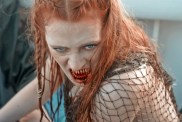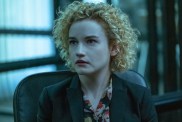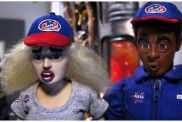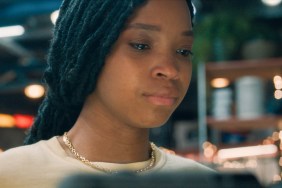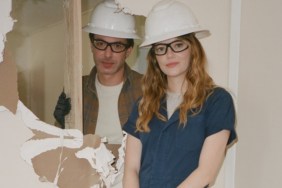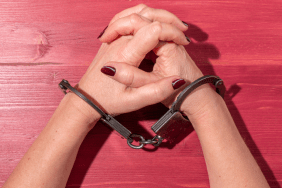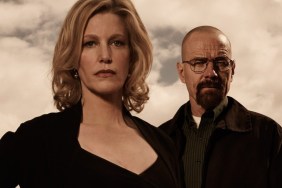One of the documentaries that received early raves out of this year’s Sundance Film Festival was The Queen of Versailles, the new film from photographer Lauren Greenfield, which follows Florida’s “Timeshare King” David Siegel, his trophy wife Jackie and their eight kids.
In 2008 the Siegels decided to build an enormous 90-room mansion based on Versailles, but later that year, the market collapsed causing a housing crisis that has a direct impact on Siegel’s business with thousands of employees laid off. Not long after, the Siegels themselves need to tighten their belts, a tough thing for Jackie, having gotten used to her exorbitant lifestyle and it seems like their unfinished mansion paradise may go into foreclosure.
While The Queen of Versailles offers enough entertainment for those who enjoy the fly-on-the-wall rubbernecking offered by VH-1 reality shows, under the surface there’s a far more layered commentary on how the rich squander so much money to create a specific lifestyle image and how the financial crisis didn’t just affect or impede those who are struggling with money. One might think that David and Jackie are odd and possibly even unlikeable subjects for a movie, but having her cameras there to capture their day-to-day, Greenfield shows their gradual transformation over the course of three years.
Greenfield won a directing award at Sundance for her work on this documentary, but ComingSoon.net had a chance to talk to her a few months later as The Queen of Versailles played a number of other festivals before its release.
ComingSoon.net: I’m familiar with your photography background and I know you’ve made other docs, but this one feels like a movie that started as one thing and got changed into another due to the circumstances. That being said, what was your first contact with the Siegels and your inspiration to make a movie about them?
Lauren Greenfield: Since I come on the film side from cinema verité, I don’t necessarily have a really fixed idea of what the movie is, but it started out as a movie about this family building the biggest house in America. When I met Jackie, I was photographing Donatella Versace for Elle Magazine in Beverly Hills. Jackie was just there at the party; she was one of Versace’s best customers at the time. They actually had been flown out by the Versace people for the party. I made this picture of her purse, which was this gold blingy Versace purse. It’s actually in the film in one of the scenes and two other purses of her friends. That picture was in the TIME Magazine Pictures of the Year, and so we stayed in touch about that. At this party, her friends told me she had seven kids, and I was working on a project about women and aging. She showed me this picture of all the kids on the wing of their private jet, so I was intrigued. We stayed in touch, and then found out she was building the biggest house in America. I went down to see her. Basically, the biggest house in America was kind of the premise or the backdrop, but it was really more about Jackie and the family. I fell in love with the setting and these characters when I went there. They lived in the 26,000 square foot house that you see in the movie. There were eight kids, one that she adopted from poverty, the niece, and in a way of domestic help from different cultural and ethnic backgrounds, and there was just this crazy energy in the house. I had been working on a project about wealth for several years, and Jackie was a very unusual billionaire. She has that kind of down to earth quality and kind of openness and generosity of spirit and usually I find very wealthy people have a kind of protective veil. The first time I went to photograph her, I said, “Is there a hotel nearby that you can recommend?” She said, “Oh, come stay at the house.” When an assistant sent me a map of the house, she sent me it via Google satellite and I saw the three guesthouses, and we would be perfectly comfortable with myself and my assistant.
CS: Did you stay there while you were filming?
Greenfield: I stayed part of the time, and then, a lot of the time myself and the crew stayed nearby. But, then I realized basically that there was a really scary dog, and at some point I thought, “Well, maybe I won’t scare.” It was basically about the fourth shoot when I knew the story was changing.

CS: You started shooting the movie in the summer of 2008?
Greenfield: Well, I met Jackie in 2007, and then the story really started to change in the middle of 2010 when the house went on the market. I think probably things from the crash were affecting his business, but it took a long time before it affected their personal lifestyle. I never really dreamed it would affect them. I mean, most rich people put money aside and have a big cushion. Their life was so big, that it took a long time for it to really affect them. When it did, it was a big surprise to me, because it really wasn’t until they put the house on the market that I realized the extent that they were affected. David, on that trip, when they put the house on the market told me that he hadn’t put anything aside. It was later in the process that I ended up including the part about his parents, and his parents being gamblers in Vegas. He really gambled everything on his business. He believed so much in his business, and it had grown for 30 years, that like many people during the boom, he assumed it would never change. Every penny he had, he put into growing the business to the point of taking out mortgages on both his house and Versailles to get more cash for the Vegas property. It really wasn’t until they had to put the house on the market, and (since) the house had been the premise for the film that I was like, “Okay, this is going in another direction.” Plus, that trip was when I really saw the stress and the strain in the house.
CS: Were you actually filming gradually over those two years?
Greenfield: Yeah, I was filming every few months. I would come for a week or so. Usually, I came for the Miss America party, and it was actually at David’s 75th birthday party, that I came for that, and then during that trip, they put the house on the market. There was a lot of luck and serendipity in a way, because I would go for some random reason just feeling like it was time to go, and then, every time something big happened. It was just kind of uncanny. Then, basically on the last trip was the day that they were in default on Versailles, and Jackie actually found out by listening in on my interview, and then reacted to that.
CS: Were you editing as you went along? You must have been shooting a lot of footage and must have had quite a bit edited together before the story started changing.
Greenfield: Most of the editing happened in the last six months, but we were really down to the wire for Sundance. Our layback (transferring the mixed audio to the video master) was the Saturday before. We opened Sundance on a Thursday, and our layback was the Saturday. I really didn’t know if I was going to finish in time until the very end because it wasn’t until the week before Thanksgiving that David lost possession of the Vegas tower. I realized at a certain point that the Tower was more important to him than the house, and that was really the thing because his parents, they always went to Vegas, because he was going to make $2 billion with the tower, because it was the most prestigious location on the Las Vegas strip with the Westgate name in lights brighter than any other light in Las Vegas. They actually passed an ordinance after saying you can’t have a light that bright. It was a real cliffhanger what was going to happen with Vegas because he was working till the end to try to keep it. It could’ve ended with him keeping it, too, but it didn’t, and he lost possession and then I knew there was an ending.
CS: So you already had it scheduled to premiere at Sundance before the story was actually finished?
Greenfield: Well, I had submitted a rough cut that was pretty rough.
CS: But you didn’t know whether you’d have an ending or not. That’s quite lucky then.
Greenfield: Some stuff had already happened, like the house had already gone into default, but the Westgate hadn’t. Now that I look back on it, I get anxious just thinking about it, but yeah, I guess it could’ve just taken longer.
CS: I imagine that must happen a lot with docs that play at Sundance, where they’re rushing to finish and then something big happens that needs to be added to the finished movie. A good example is “Paradise Lost,” where they basically they finished the movie and all of a sudden something huge happened. So has the movie changed since Sundance? I thought there was more with Jonquil, their adopted niece.
Greenfield: No, no. (laughs) That’s in the bonus scenes. There was a lot of Jonquil we didn’t end up using but she’s so great.

CS: As a photographer, people must be comfortable with you taking their picture, so did you use some of the techniques when interviewing people like David and Jackie and the maids and getting them to open up to you?
Greenfield: I feel like the interviews I’ve done in my photography since I started
even in college, my first project was about the French aristocracy, and I did first person interviews with that. Even though in my shows and the books, they were just used as text, I’ve done that process for a while. It’s part of my process, yeah. I think that did come fairly naturally. I mean, what was new for me in this film
well, this is my fourth film, my second feature length film. In a way, I felt like it was the first film that I was able to bring over the aesthetic from my photography, and also the kind of sociological perspective from my photography into the film. When I did “Thin,” the access and my relationship with the girls was like my photography, but the aesthetic was just kind of pure verité, run and gun.
CS: You used a DP on this one, which was surprising since I’d assume as a photographer, you’d want to handle the camerawork and shots yourself.
Greenfield: I’ve always used a DP, yeah. I shoot second camera, and then I shot some stills as we were working, too, but I really love stepping back and getting to be the director. In this one, it was a different kind of narrative. I took this to the Sundance Lab and I really worked on the narrative structure there, and also, because I kept going back to the same place, I had the chance to do pick-ups, so if we’re missing a picture, like a shot of the house. It was less just intuitive, follow the action like “Thin” was. I did work with a DP, Tom Hurwitz, who is great, and a couple of other women, Shana Hagan, Sarah Levy, who I’ve worked with before. I think they all tried to have the look of my picture. Even though they’re working and thy were in the moment, I think they were also thinking also about the aesthetic of my pictures–being really close, being wide angle. Then, the thing that’s different about this film is there are a lot of interviews in it. The interviews I’m composing because they’re locked off interviews. The thing that happened with these interviews is, like with Jackie, I did five interviews. With David, I did five interviews. With most of the other characters, I did at least two. I started kind of treating the interviews like verité, like there was a lot of information in them that wasn’t just the talk. One of the things you see in the progression of the interviews is how taxing this is for David.
CS: Of course. His transformation through the movie is really shocking, because if you go back and look at him at the beginning of the movie, he’s completely different.
Greenfield: And Jackie, too, in a way. I mean, she’s still really peppy and optimistic at the end, that’s her character, but physically I feel like she looks changed. Then, Victoria also has this incredible transformation. I was afraid people wouldn’t recognize her at the end. That was really neat, to kind of get to do the longitudinal. It wasn’t even that longitudinal, but because they had had such intense experiences, whether it was the financial stress or puberty, there was this real transformation.
CS: As the movie begins, it seems like it could just be a reality show about this super rich family and there’s a lot of light humor and also things that are said that are extremely poignant. Is this stuff you realize while you’re shooting it or did it only become obvious later how funny certain things were in the context of the movie.
Greenfield: Well, Jackie has a great sense of humor, and I think in a film, you can’t quite tell whether sometimes she’s in on a joke, sometimes she’s not in on a joke. I think she’s in on it more than you’d think, in a way, because she is really smart and she has a great sense of humor, so we definitely laughed a lot making the film. I think there’s also a real tonal change because in the beginning there are a lot of laughs, and they have this kind of outsized, over the top lifestyle that in some ways you think you can never relate to because it’s so big and it’s so crazy building this house and flying around in jets. Then, I think after they start dealing with financial stress, you kind of see how in a way, they’re not that different from what a lot of people went through in the financial crisis, and that kind of brings them down to earth. I think they have a unique quality that allows that to happen because they both came from humble origins and they’re both survivors. So the way they deal with this stress is relatable. I think that’s the surprise in the film, is that you can relate to them, that they are empathetic, and that you do see that.

I tried to emphasize this by bringing in the minor characters like Cliff, who lost 19 houses, and to see what David did is what so many of us did in the boom and then in the housing crisis. At the end he kind of says the moral of the story like, “I should’ve been happy with 15 resorts instead of 28. It was a vicious cycle driven by greed.” He’s in this unique place to kind of say that because he was on both sides, he was selling the mortgages and he’s beholden to the lenders. For me, the story was not just about a family or about a rich family, but it really became an allegory of the overreaching of America. I think in the beginning you might be laughing, but in the end you’re kind of like, “How did I participate in that, too? Like, did I put too much on my credit card or buy too much of a house?” Along the way, I’ve been photographing this wealth story in a lot of different ways. One of the things I did was photograph foreclosure city in California, and in the Inland Empire, and that’s a place where middle class people bought reasonably priced homes, then the homes went up in value, they pulled tons of money out of their house and they built pools and rock fountains and tiki bars. By the time I got there to photograph, they were abandoned and pestilent green water in the pool, and the police coming to drain the pools because they were worried about West Nile Virus. When I saw Cliff’s green pool, that was really symbolic for me of foreclosure. Even the Versailles pool, empty pools becomes filled with yucky water.
CS: One of the inadvertently funny things was at the Christmas party when he opens his present and it’s the game of Monopoly and then his next present is the game of Risk. There was something to that which I just found brilliantly funny.
Greenfield: (laughs) I’m so glad you said that. It’s funny because at the end, it was too long. I was cutting and I’m like, “Should we cut the game?”
CS: No, no. That’s a great scene. How much stuff do you have left over? Have you already started putting together some idea of what you want to include on the DVD?
Greenfield: I have not, no. I mean, it was pretty efficient. Actually, I shot less than I did for “Thin,” even though it was over a much longer period, probably about 180, 200 hours of footage.
CS: Oh, that’s not bad.
Greenfield: It really was pretty efficient. I mean, I think partially because there are a lot of interviews, and partially because it was just kind of life with the Siegels. It would we’d go in for a seven-day period or a three-day period. Also I think my DP Tom Hurwitz is more old school, so he was
CS: He’d just shoot what you need.
Greenfield: Yeah. (laughs)
CS: What happened with Versailles? Did they just tear it down?
Greenfield: No, Versailles is still on the market. They lowered the price $10 million, so now it’s available for $65 (million). It was going into foreclosure at the end of the movie, and Bank of America had put it up for auction. David borrowed a million dollars to stave off the auction six months–that’s where the movie ends. Six months later, they put it up for action again, he borrows $25 million.
CS: So he’s still trying to keep it.
Greenfield: He’s trying to keep it. They have a big mortgage, so in a way, the story goes on.
The Queen of Versailles opens in New York City at the Angelika and Elinor Monroe Film Centers and in L.A. at the Landmark 12.
